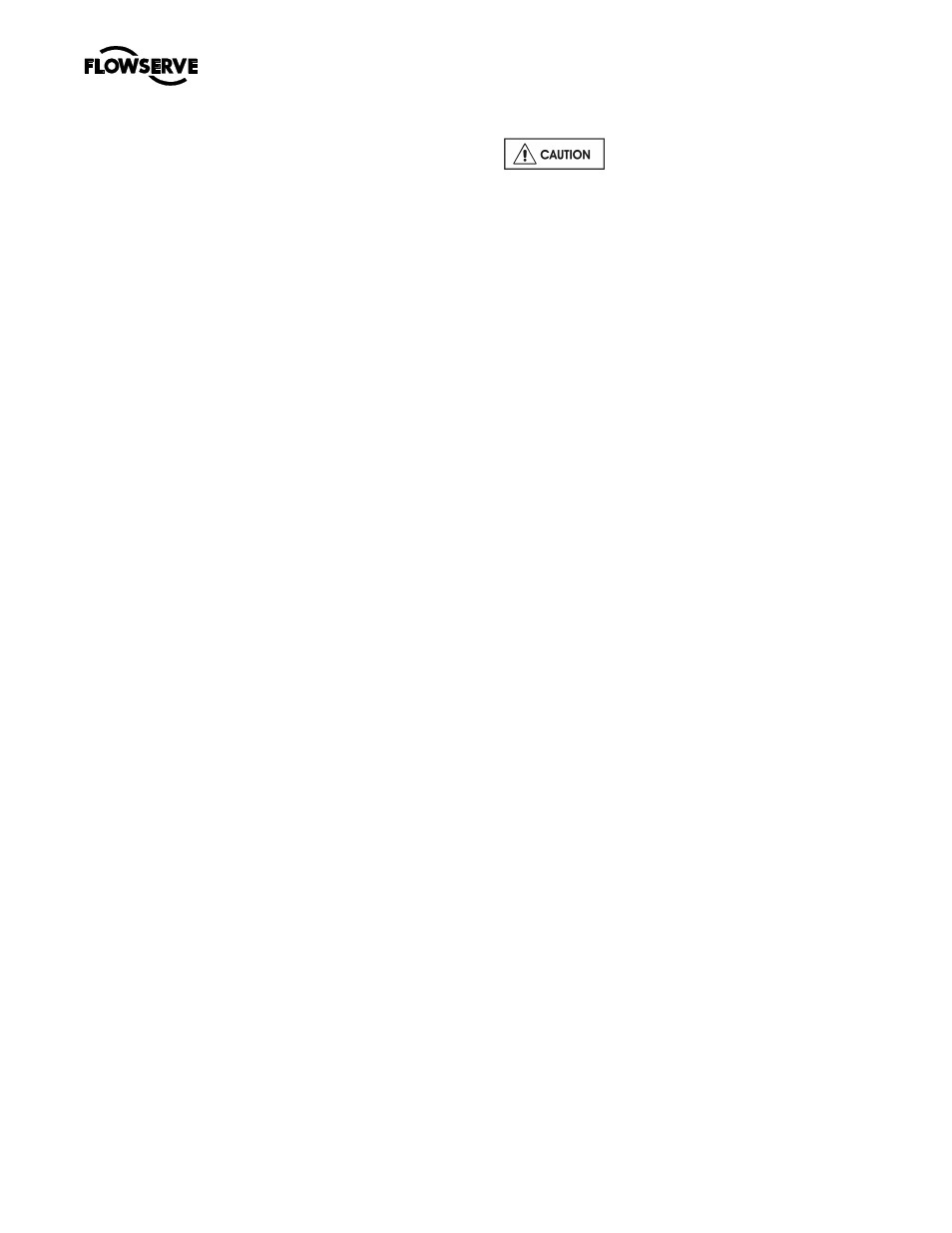Flowserve MARK 3 GROUP 4 User Manual
Page 35

MARK 3 GROUP 4 USER INSTRUCTIONS ENGLISH 71569286 08-12
Page 35 of
48
flowserve.com
®
b) The mechanical seal cover can also be removed
by placing a wedge into the gland chamfer, as
below:
6.8.2.2 Impeller and stuffing box
a) While preventing the shaft from rotating, remove
the impeller nut [2912] that has a right hand
thread.
b) Remove the impeller [2200] and impeller key
[6700]. Normally, a slight tightening of the thrust
gearing jacking screws will free the impeller and
allow it to be removed. Except on the smaller
sizes, there is a facility on the impeller hub to
assist removal in difficult cases.
6.8.3
Shaft sleeve
a) Remove the shaft sleeve gasket [4590.3].
b) Remove the shaft sleeve [2445] if scored or
worn.
6.8.4
Bearing housing
a) Remove the line bearing seal.
b) Remove the pump half coupling and coupling key
[6710].
c) Remove the bearing frame support [3134].
d) Lift the bearing frame assembly into a vertical
position with the thrust bearing housing [3240]
up. Rest the bearing frame flange on heavy
wooden blocks sufficiently high to ensure end of
the shaft does not come into contact with the
floor or table.
e)
Remove the thrust bearing hold down bolts and
remove shaft assembly for the bearing frame
[3130].
6.8.5
Line bearing
a) Lay the shaft [2110] horizontal and support with
wooden ‘V’ Blocks.
b) Only if necessary remove the line bearing [3011]
from the shaft. Bearings removed and reused
can easily be damaged and undetected until
pump is put back in operation.
6.8.6
Thrust bearings
a) Lay the shaft [2110] horizontal and support with
wooden ‘V’ Blocks.
b) Remove the thrust bearing clamp ring [2542]
from the thrust bearing housing [3240].
c) Bend up the locking tab on the bearing
lockwasher [6542] and remove the bearing
locknut [3712] and lockwasher [6542].
d) Only if necessary remove the thrust bearings
[3031] from the shaft. Bearings removed and
reused can easily be damaged and undetected
until pump is put back in operation
6.9 Examination of parts
Used parts must be inspected before
assembly to ensure the pump will subsequently run
properly.
In particular, fault diagnosis is essential to enhance
pump and plant reliability.
6.9.1
Casing, seal housing and impeller
a) Inspect for excessive wear, pitting, corrosion,
erosion or damage and any sealing surface
irregularities.
b) Replace as necessary.
c) Inspect the impeller [2200] for excessive wear or
damage. Inspect the casing [1112] and stuffing
box head [4110] for damage or excessive
thinning of wall sections due to wear or
corrosion. Clean the internal surfaces to
maintain pump efficiency.
d) Clean the internal bore of the stuffing box.
6.9.2
Shaft and sleeve [if fitted)
a) Replace sleeve if grooved, pitted or worn.
b) Clean the shaft and inspect for evidence of
corrosion, evidence of cracking, fatigue or
mechanical damage. Remove all burrs or nicks
paying particular attention to the areas under the
lip seals. Check that the shaft is straight within
0.002 inch (0.050 mm).
6.9.3
Gaskets and O-rings
After dismantling, discard and replace.
6.9.4
Bearings
a) It is recommended that bearings are not re-used
after any removal from the shaft.
b) The plain liquid lubricated bearings may be re-
used if both the bearing bush and bearing sleeve
show no sign of wear, grooving or corrosion
attack. (It is recommended that both the bush
and sleeve are replaced at the same time.)
6.9.5
Bearing isolators, labyrinths or lip seals
(if fitted)
a) The lubricant, bearings and bearing housing
seals are to be inspected for contamination and
damage. If oil bath lubrication is utilised, these
provide useful information on operating
conditions within the bearing housing.
b) If bearing damage is not due to normal wear and
the lubricant contains adverse contaminants, the
cause should be corrected before the pump is
returned to service.
c) Labyrinth seals and bearing isolators should be
inspected for damage but are normally non-
wearing parts and can be re-used.
